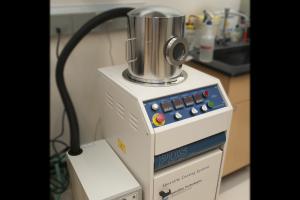Training is offered as needed. Contac the tool manager.
Since a typical deposition takes 4-5 hours, the training session is broken into 2 parts. First part is in the morning & lasts 45 minutes. The second part lasts 1 hour when the run is completed, and it also covers training on the 2nd floor Veeco Dektak profilometer so that parylene thicknesses can be measured.
- None
The PDS 2010 LABCOTER deposition system is designed for deposition of protective Parylene conformal coatings. It is set only for Parylene C. This is suitable for laboratory research applications, circuit board repairs, electronic sensors, medical components, organic samples, and many other substrates.
The deposition process begins with the granular form of Parylene C, raw material dimer. The material is vaporized under vacuum at 175C . The dimeric gas is then pyrolized at 690C to cleave to the monomeric form. In the room temperature deposition chamber, the monomer gas deposits as a transparent polymer film. The required thickness of a coating varies based on the application. Thickness range from the hundreds of angstroms to 10 microns. Depositions are affected by the vacuum pressure and variations in the tool and can vary by 10% from the data chart. Because of this, no guarantees are given for run-to-run reproducibility of the coating.
Good to excellent adhesion of Parylene C to a variety of substrates can be achieved by the simple treatment with a dilute solution of an organic silane prior to coating. Parylene exhibits very little absorption in the visible region and is, therefore, transparent and colorless. Below about 280 nm Parylene C absorbs strongly. It resists room temperature chemical attack and is insoluble in all organic solvents up to 150° C. Chemical resistance and moisture vapor permeability rates for Parylene C are superior to almost all polymeric materials.

